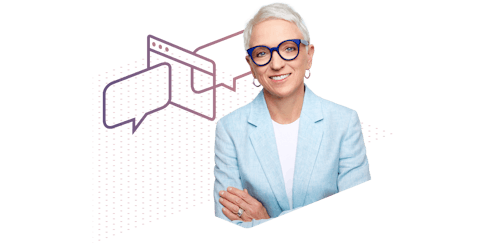Sales Enablement vs. Sales Enablement
Improving win rate

Sales Enablement Vs. Buyer Enablement: What's the Difference?
With the help of sales enablement, it’s never been easier for sellers to sell. But what about the buyer experience? Sales enablement surrounds only the needs of the sales team, providing only half of the solution. To address the buyer’s needs and concerns, sellers also need to leverage buyer enablement. When it comes to sales enablement vs. buyer enablement, the differences are clear. Sales enablement helps the internal sales process, while buyer enablement empowers buyers to make an educated, timely purchasing decision. Simply put, buyer enablement helps close deals faster by providing buyers with information and tools that align with their goals and address their concerns. This enables buyers to feel confident in their purchasing decisions, create a stronger relationship with the seller, and simplify the buying process.
Using Buyer Enablement to Outsell the Status Quo
Repeated decision-making is exhausting. As a result, each additional decision a buyer makes will deplete their resolve to advance to the next step.
Consider research published in the Proceedings of the National Academy of Sciences of the United States of America, which found that this phenomenon occurs even within the justice system in which every ruling is a high-stakes decision.
Researchers learnt that “the percentage of favourable rulings drops gradually from ≈65% to nearly zero within each decision session.” The finding echoes a previous body of data showing that repeated decision-making depletes our executive functioning.
When faced with mounting choices, buyers gradually simplify the decision by resorting to the status quo. Researchers call this tendency “status quo depletion.” These findings are a reminder that becoming better at sales enablement means getting better at buyer enablement.
When sales enablement professionals provide sales professionals with insights and information designed to simplify the customer’s decision process, they are leveraging the power of buyer enablement.
Here, we look at why strong sales enablement is strong buyer enablement by discussing the key skills needed for each capability.
Sales Enablement: Map Content to the Buyer’s Journey
The buyer’s journey is not linear. It is dynamic and iterative. Stakeholders enter and exit the picture. Needs change and competing for internal priorities can slow or even stop the buying process. As a result, sales enablement professionals must be able to track and predict these changes so that they can map their material to turns in the road. By doing so, they can provide marketing collateral, data, and insights that are salient not only to the customer’s end goal but also to top-of-mind issues at that particular stage of the buyer’s journey.
Learn more about the modern buyer journey by downloading the white paper:
Embracing the Turns, the New Buyer Journey
Making this approach work means that enablement professionals must first understand what underlying factors are driving these changes in the buyer’s journey.
Here are the four key factors at work:
- Customers are bringing more rigour to the buying process.
- Customers are conducting this research with fewer resources and less time.
- Customers are experiencing heightened sensitivity to risk.
- Customers have everyday business routines that hinder the purchasing process.
Sales enablement professionals must be aware of these four key challenges so that they can identify when they have occurred. Once they have identified which factor the customer is facing, they can enable the sales professional to respond appropriately.
For example, enablement professionals can provide sales professionals with clear, and relevant data supporting the effectiveness and ROI of the solution to address the customer’s increased rigour. Additionally, sales enablement professionals can provide sales professionals with concise case studies that illustrate the solution’s real-world outcomes to help ease the customer’s sensitivity to risk.
One key capability underpinning these examples is speed. With a faster response time, sales enablement professionals help sales professionals limit the degree to which customer concerns are left languishing. These customer hesitations must be addressed in the moment to keep them from solidifying.
Buyer Enablement: Simplify the Decision Process
Strong buyer enablement means carefully selecting which material to provide sales professionals to help them pave the way to a purchase. This process is akin to choosing the right tool at the right time for the specific part of the job at hand. Sales enablement professionals can do so by adhering to three key principles:
Provide Concise Data to Support the Solution
The process of understanding data should not be burdensome for the customer. The data should be limited to only what is salient. The information should be presented in a way that allows it to be understood immediately. Therefore, enablement professionals should consider the cognitive load of the information.
Doing so means providing clear and simple supporting data, and using video and visuals over descriptive language. As business challenges and corresponding solutions become more sophisticated, it is more important than ever to distill complex messaging into small, digestible content.
Limit the Available Options
Enablement professionals should equip the sales professional to position the solution in one or two configurations. Presenting the customer with a long list of options only complicates the issue. As the research from the National Academy of the Sciences shows, each additional decision a person makes taxes their cognition and encourages them to resort to the default choice: the status quo.
When presenting the shortlist of options, the enablement professional should help the sales professional create clear sales messaging that links the solution to the challenges. The key is to make the solution salient to the stakeholders.
Illustrate the Path to Implementation
Business solutions are more complex than ever. Therefore, implementation is a critical focus for customers. The stakeholders need to know how the solution will seamlessly integrate with their existing practises. Therefore, enablement professionals must help the sales professionals articulate how implementation will work. This articulation must be free of technical language or jargon. The customer needs to know how the sales professional’s role will evolve from a problem solver to an implementation resource over the long term.
Here, it is helpful to offer specifics. Enablement professionals can provide sales professionals with dates and milestones to share with the customer. For larger, more sophisticated solutions, it is often helpful to divide the implementation process into phases with clear delineations.

CRM Enabled Workflow Tools
We support our partners with a full suite of CRM tools that align with different phases of the sales cycle – from call planning and account growth to ongoing sales enablement and marketing. Each tool complements skills developed in our sales training programmes.
Learn MoreExceptional Sales Enablement = Stong Buyer Enablement
Good sales enablement practises demand strong buyer enablement practises. Stakeholders encounter a complex web of decisions. Enablement professionals should align enablement material with each stage of the buyer's journey, aiming to streamline the decision-making process for the buyer.
Contact us to learn how you can enable your sales professionals throughout the buying journey.

Brief: Driving CRM and Sales Enablement Success
DownloadGet industry insights and stay up to date, subscribe to our newsletter.
Joining our community gives you access to weekly thought leadership to help guide your planning for a training initiative, inform your sales strategy, and most importantly, improve your team's performance.






